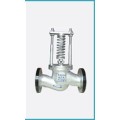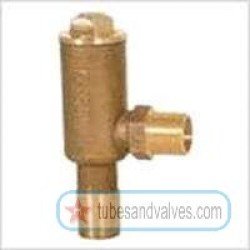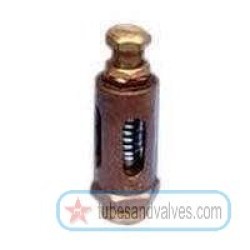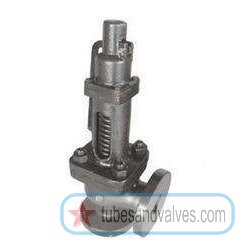Safety Valve: A Vital Part of Equipment Safety and Efficiency
A safety valve is a critical piece of equipment when it comes to the safe and efficient operation of any industrial or commercial operation. Designed to keep a system from potentially hazardous over pressurization, a safety valve is designed to control or limit the excessive pressure that can otherwise harm a system, or cause unacceptable damage or injury. Furthermore, safety valves are designed to recognize and resolve any pressure-related safety issues before they become catastrophic for a given system.What Is a Safety Valve?
A safety valve is a device usually fitted with a valve orifice, engineered to mechanically control the direction, rate and pressure of any harmful type of liquid or gas that may be flowing through a closed circuit. Generally, a safety valve is defined as “a device that activates when a certain pressure is exceeded in order to protect an equipped system from any dangerous and potentially damaging pressure surges”.Why Are Safety Valves Used?
Safety valves are typically used in order to:1. Provide a simple yet effective method to control the flow of fluids or gases in a variety of industrial and commercial applications. 2. Attain a state of safety within a system in order to reduce the chances of catastrophic failure and minimize any expected damage. 3. Quickly equalize any pressure differential that might occur within a system or yield an unexpected level of pressure drop in order to allow personnel to safely maintain any process that utilizes the particular fluid or gas.What Types of Safety Valves Are Available?
Safety valves come in numerous types, sizes and shapes, depending upon their exact purpose and the application in which they are intended for. Generally, safety valves are categorized based on its controlling fluid pressure, fluid valve and the wet or dry character of the flow.Common types of safety valves may include:1. Relief valves 2. Surge relief valves 3. Pilot-operated relief valves 4. Safety relief valves 5. Pressure relief valves 6. Anti-surge valves 7. Back pressure valvesHow Do Safety Valves Work?
Safety valves are designed to activate upon the occurrence of an excessive pressure or when the pressure reaches its maximum limit. When pressure levels exceed their predetermined limits, the safety valves will open suddenly and allow the excess pressure to be released. This is done manually or automatically, depending on the type of safety valve being used.Benefits of Utilizing Safety Valves
1. Reduce potential risks in high-pressure operations by protecting workers, equipment, and surrounding environment. 2. Improve system efficiency by reducing the chance of unexpected failures. 3. Provide automated protection with minimal maintenance over a long period of time. 4. Ideal for monitoring and continuously monitoring the pressure within a system, which helps to ensure that it is functioning safely and efficiently.Conclusion
Safety valves are an essential component of any high-pressure system. By providing an effective and reliable way to limit or relieve dangerous and potentially hazardous excess pressure, these valves play an important role in safeguarding equipment, personnel and the environment from any potential risk caused by a system’s over pressurization. With proper installation and maintenance, safety valves can play a key role in ensuring the safety and efficiency of any high-pressure operation.FAQs for Safety Valve
Frequently Asked Questions for Safety Valve
What is a safety valve?
A safety valve is a device that is designed to automatically release pressure from a system when it exceeds a certain level. It is commonly used in steam boilers, pressure vessels, and other systems that contain pressurized fluids or gases.
Why is a safety valve important?
A safety valve
BRAND: ATAM VALVES
Model: 65072
GUN METAL SAFETY VALVEATAM Gun Metal Safety Valve is a high-quality safety valve designed for various applications in water, gas and oil industries. The valve is made of gun metal, a type of bronze alloy, that is known for its high strength and corrosion resistance. It has a nominal bore size of 1..
Price INR 1,601.00
BRAND: ATAM VALVES
Model: 65071
Introduction:A safety valve is an essential part of any piping system that is designed to release excess pressure if it exceeds the maximum limit. It is used to protect the piping system from damage and provide safety to the equipment and people working with it. ATAM Gun Metal Safety Valves are on..
Price INR 1,141.00
BRAND: ATAM VALVES
Model: 65072
GUN METAL SAFETY VALVE S/E-SCREWED END-THREADED END ENCLOSED / ANGLE TYPE ATAM is a high-quality safety valve designed to regulate the flow of gases or liquids in pipelines. The valve is made from durable gun metal material, which ensures that it will withstand extreme temperatures, corrosive fluids..
Price INR 2,287.00
BRAND: ATAM VALVES
Model: 65071
Gun Metal Safety ValveA safety valve is a critical component of any pressurized system. It is designed to automatically discharge excess pressure when the system reaches a certain threshold. In industrial settings, safety valves are often made from sturdy materials such as gunmetal, which is a typ..
Price INR 1,559.00
BRAND: ATAM VALVES
Model: 65072
A safety valve is a small but crucial component in any working system. It ensures that a system does not exceed its maximum safe working pressure, preventing leaks, ruptures, and other dangerous situations.The Atam Gun Metal Safety Valve is a reliable and durable safety valve designed for industri..
Price INR 3,161.00
BRAND: ATAM VALVES
Model: 65071
Gun Metal Safety Valves are an essential component in a wide range of industrial applications, particularly those in fluid handling systems. These valves help regulate the flow of liquids and gases, ensuring that they are properly directed and controlled within a system.One of the most popular mod..
Price INR 2,432.00
BRAND: ATAM VALVES
Model: 65072
The 32mm NB or 1 1/4 inch NB ATAM gun metal safety valve is a high-quality safety valve that is designed to provide reliable and effective protection against overpressure in a wide range of industrial applications. This safety valve is made of durable and corrosion-resistant gun metal and designed f..
Price INR 4,127.00
BRAND: ATAM VALVES
Model: 65071
32mm or 1 1/4" NB ATAM GUN METAL SAFETY VALVE S/E-SCREWED END-THREADED END STRAIGHT / OPEN TYPE ATAM
The 32mm NB or 1 1/4 inch NB ATAM Gun Metal Safety Valve is an essential component in industries such as petrochemical, chemical, pharmaceutical, and food processing. This high-quality safety valve is designed to provide reliable pressure protection for equipment and pipelines, in order to avoid pot..
Price INR 3,445.00
BRAND: ATAM VALVES
Model: 65072
GUN METAL SAFETY VALVE S/E-SCREWED END-THREADED END ENCLOSED / ANGLE TYPEA safety valve is a crucial component in any industrial piping system. Its primary function is to prevent hazardous conditions that may arise due to an increase in pressure. The ATAM gun metal safety valve is a widely used va..
Price INR 6,694.00
BRAND: ATAM VALVES
Model: 65071
40mm or 1 1/2" NB ATAM GUN METAL SAFETY VALVE S/E-SCREWED END-THREADED END STRAIGHT / OPEN TYPE ATAM
IntroductionWhen it comes to industrial applications, safety valves play a crucial role in ensuring the safe operation of equipment and processes. They are designed to prevent overpressure, which can cause damage to the equipment or even result in catastrophic accidents. The Atam Gun Metal Safety ..
Price INR 4,643.00
BRAND: ATAM VALVES
Model: 65072
The ATAM Gun Metal Safety Valve is a precision engineered product designed to provide superior safety and protection for industrial processes and equipment. With a diameter of 50mm NB or 2 inches, this valve is able to handle high-pressure fluids and gases, making it ideal for use in a wide variety ..
Price INR 8,862.00
BRAND: ATAM VALVES
Model: 65071
GUN METAL SAFETY VALVE 50mm NB or 2 inch NB S/E-SCREWED END-THREADED END STRAIGHT / OPEN TYPE ATAMThis safety valve is designed and manufactured with highest standards of quality to ensure reliability and safety in various types of applications. It is made of gun metal, which is a type of brass th..
Price INR 6,449.00
BRAND: CREST
Model: SP LD SAFETY
When it comes to industrial and commercial applications, safety should be the top priority. This is where safety valves come into play. Valves are designed to automatically release excess pressure or prevent it from building up in a system. One of the most commonly used safety valves is the spring l..
Price INR 16,622.00
BRAND: CREST
Model: SP LD SAFETY
25mm NB or 1 inch NB Cast Cast Steel ND-40 straight Pattern spring Loaded Safety Valve FlangedA safety valve is an essential component of the industrial process, which is designed to protect equipment and personnel. A safety valve is employed to protect the system from overpressure, which can resu..
Price INR 3,836.00
BRAND: CREST
Model: SP LD SAFETY
The 40mm NB or 1 1/2 inch NB Cast Steel ND-40 Straight Pattern Spring Loaded Safety Valve Flanged is an essential safety device used in various industries to protect equipment and workers from possible accidents. This type of valve is made of cast steel, which makes it durable enough for heavy-duty ..
Price INR 5,670.00
BRAND: CREST
Model: SP LD SAFETY
Introduction:Safety valves are sure ways of ensuring the safety of industrial plants. They are designed to release excess pressure in a system promptly. This prevents pipes and equipment from bursting, which can cause catastrophic loss of property and personnel. Cast steel safety valves are common..
Price INR 6,796.00
BRAND: CREST
Model: SP LD SAFETY
The 65mm NB or 2 1/2 inch NB Cast Cast Steel ND-40 straight Pattern spring Loaded Safety Valve Flanged is a highly durable and reliable safety valve designed to ensure the safety of individuals and equipment in various industrial settings. The valve is manufactured from high-grade cast steel, which ..
Price INR 10,678.00
BRAND: CREST
Model: SP LD SAFETY
When it comes to ensuring safety in industries, safety valves play a significant role. These devices are designed to release pressure from pipes and vessels to prevent them from bursting due to excess pressure. The 80mm NB or 3 inch NB Cast Cast Steel ND-40 straight pattern spring-loaded safety valv..
Price INR 11,751.00
Showing 1 to 18 of 18 (1 Pages)
















































